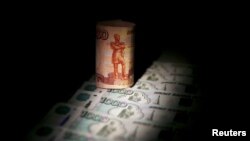Since the start of 2017, the price of Brent crude oil, a key factor influencing the ruble exchange rate, has dropped by nearly 16 percent. However, not only did the ruble exchange rate to the dollar not depreciate, it actually rose by 5 percent. This phenomenon triggered reaction from top Russian officials about an “optimal” or “just” ruble exchange rate. Opinions on such a rate ranged from 60 to 65 rubles to the dollar, all much lower than what the ruble has been fetching for the dollar recently.
The current ruble exchange rate of 57 to the dollar is nearly 9 percent higher than the figure Manturov considers to be “optimal” for “import substitution.” The sharp slowdown in the inflation rate in Russia (from 5.4 per in December to 4.1 percent in May, near record levels for modern-day Russia) is largely due to the robust ruble rate, notes Natalya Orlova, chief economist at Alfa Bank, the biggest private-sector bank in Russia. Indeed, imports in retail trade account for about 40 percent, adds Mikhail Khromov, head of the Finance Department at the Gaidar Institute for Economic Policy (IEP).
Over the past two years, some 375 billion rubles ($6.6 billion) have been allocated to import substitution projects in Russia, with a quarter of that sum coming from the state. And the results? Humble to say the least. And this despite a double dip in the value of the ruble, making imports more expensive and stimulating, in theory anyway, domestic production. However, as noted by Vladimir Salnikov, deputy director of the Center for Macroeconomic Analysis and Short-Term Forecasting, for the 2014-2015 period Russian manufacturers’ spending on imports dropped only marginally from 53 to 46 percent, but rose again to 47 percent in 2016. For the Russian economy as a whole, expenditure on imports dropped slightly from 15.3 percent in 2014 to 14.9 percent in 2015, before rising back again in 2016 to 2014 levels. According to Salnikov, the biggest drop in imports was only registered among low-tech sectors of the economy, most notably in the food industry (cereals, dairy and meat production), although little import substitution was registered even in ancillary ones.
Such findings coincide with analysis by IEP staff, who have been polling Russian industrial enterprises for more than 25 years. At the end of 2016, 70-75 percent of these industrial enterprises polled said they were still importing the same share of raw materials and equipment crucial for their operations, according to Sergei Tsukhlo, head of the IEP’s surveys department. At least 60 percent of industrial enterprises complained they still were unable to acquire Russian-made equivalents to substitute for the imports.
The resumption of such imports starting in the second half of 2016, partly due to a stronger ruble, again put on hold import substitution in the country, noted the Russian Academy of National Economy in a report issued six months ago.
The total share of such manufacturing imports as a share of the overall import pie, explained the authors of the report, has not budged for the last three years, remaining at about 40 percent.
Moreover, it’s far from clear what sectors, if any, would be spurred to opt for import substitution under the industry minister's 'optimal' exchange rate of 62 rubles. Independent analysis has shown time and again that Russian industry backs a “stronger” ruble. A March 2017 poll by IEP found enterprises outside the gas and oil industry, considered 52 rubles to the dollar to be an optimal rate on average.Even exporters in the metals and chemicals industries, which along with the oil and gas industry, should be interested in a weaker ruble, would prefer a stronger ruble than the one stated by the industry minister. (see graph)
Interestingly, a year ago in May, industries pegged a rate of 51 rubles to the dollar as their optimal exchange. The ruble was then trading between 65 to 67 rubles to the dollar and any talk in the corridors of power at the time of an optimal exchange rate was rarely if ever heard.






